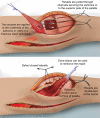Chronic Quadriceps Tendon Rupture Reconstruction with Sartorius Muscle Transfer: A Report of Five Cases
- PMID: 34476163
- PMCID: PMC8382444
- DOI: 10.1097/GOX.0000000000003785
Chronic Quadriceps Tendon Rupture Reconstruction with Sartorius Muscle Transfer: A Report of Five Cases
Abstract
Disruption of the knee extensor mechanism is an unfavorable situation because efficient mobilization requires a functioning knee extensor apparatus. The purpose of this retrospective study was to report our technique of sartorius muscle transfer for restoration of extension mechanism function and the outcomes of five patients. Patients with ruptured knee extensor mechanism secondary to trauma or knee arthroplasty-related issues were studied retrospectively. In all patients, sartorius muscle was transferred to restore the quadriceps tension deficit. Increase in the knee active range of motion, increase in the extensor mechanism power by one grade on Medical Research Council scale, and improvement in the extension lag were observed in all patients. The sartorius muscle transfer can be a reliable option to restore the knee extensor mechanism in chronic quadriceps tendon injuries. Our initial results are promising and showed improvement of the extensor mechanism muscle power, increased knee active range of motion, and decreased knee extension lag. The complications we observed did not impair the successful outcome of the sartorius transfer and were anticipated given the complexity of the studied cases. We encourage additional studies of sartorius muscle transfer to treat chronic quadriceps tendon injuries.
Copyright © 2021 The Authors. Published by Wolters Kluwer Health, Inc. on behalf of The American Society of Plastic Surgeons.
Figures


References
-
- Ricciardi BF, Oi K, Trivellas M, et al. . Survivorship of extensor mechanism allograft reconstruction after total knee arthroplasty. J Arthroplasty. 2017;32:183–188. - PubMed
-
- Clayton RA, Court-Brown CM. The epidemiology of musculoskeletal tendinous and ligamentous injuries. Injury. 2008;39:1338–1344. - PubMed
-
- Saragaglia D, Pison A, Rubens-Duval B. Acute and old ruptures of the extensor apparatus of the knee in adults (excluding knee replacement). Orthop Traumatol Surg Res. 2013;99(suppl 1):S67–S76. - PubMed
-
- Ormaza A, Moreta J, Mosquera J, et al. . Chronic quadriceps tendon rupture after total knee arthroplasty augmented with synthetic mesh. Orthopedics. 2017;40:38–42. - PubMed
LinkOut - more resources
Full Text Sources
